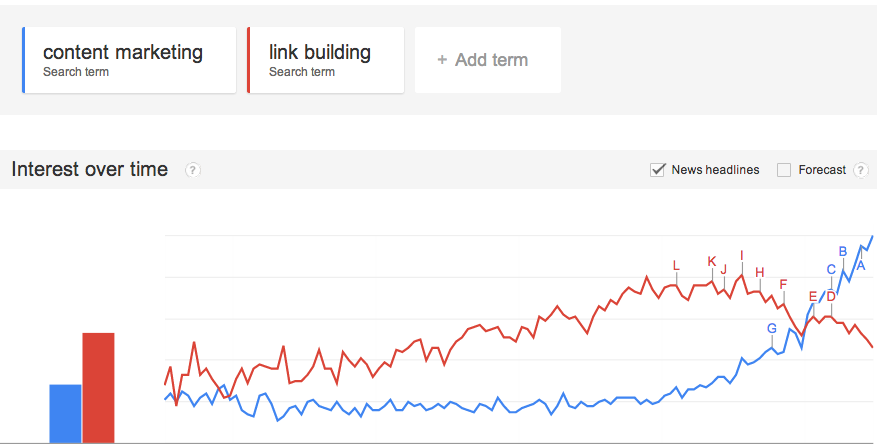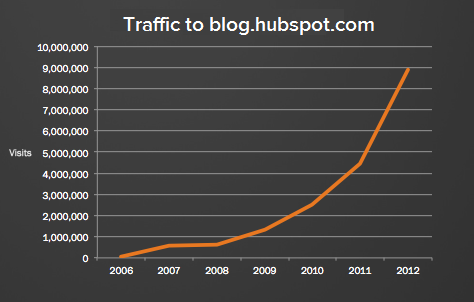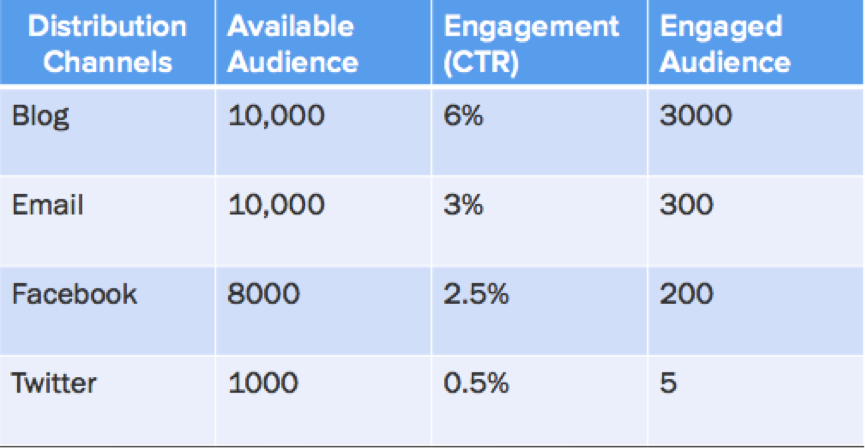by Kieran Flanagan

December 12, 2013 at 4:00 AM
The growth in content marketing this year has continued to gather pace. There is no doubt this has been influenced by the changes Google has made to their algorithm; Panda,Penguin, and Hummingbird have all helped to shine the spotlight firmly on the importance of content.
If you take a look at the increase in interest in content marketing versus link building, for instance, you'll see a dramatic decrease in the interest of link building in favor of content marketing as a search term. A lot of SEO agencies have wisely pivoted their business model in 2013 away from link building and towards content, as well.

Of course the reasons for doing content marketing stretch a lot further than just acquiring links, but this is just one chart that highlights how popular content marketing is becoming. And if you’re still stuck arguing with management about the value of content for your company, there’s a chance that you’re already too late to the party, depending on how advanced your particular industry is in the inbound marketing space.
That's why I think the decisions for a lot of marketers next year won’t be focused on how they get started with content marketing; it will be around how they make content scale or how can they distribute it to the right audience. That’s a scary prospect if it’s your competitors asking those questions and you’re still trying to get the buy in to even get started.
The stats released this year only go to highlight these trends: 73% of B2B content marketers are producing more content than they did one year ago, with 58% of B2B marketers planningto increase their content marketing budgets over the next 12 months. This figure increases to 64% when looking at the UK.
Proving the Value of Content
With so many companies now giving their marketers license to invest in content marketing, part of what a marketer needs to excel at is showing the ROI from that initial investment. How is it helping your business achieve their goals? If you're going to aim for scale in 2014, you need to show that what you're doing now is working, and will continue to work and warrant equal or more investment. Just look at this response from Simon Penson on Twitter when I asked whether executive buy-in was the biggest challenge for content marketers:
Like Simon, I don’t think getting that initial investment is the most difficult challenge content marketers have today; it’s sustaining that investment when results take time.
A lot of this is down to setting the right expectations when pitching for your initial investment. Your management team is probably used to the timeframes of success they get from paid campaigns -- or even the quick wins they had from SEO before the various Google updates of the past year. But results from content take time. HubSpot, for instance, started blogging before we even had a product. Traffic didn’t just appear overnight; it took between 12 to 18 months before it started to gain real traction:

Another great example of a brand using content to grow their user base is Bufferapp. They acquired 100,000 users from 9 months of guest blogging. That’s 150 posts. But again -- it took time and effort for them to see those results.
Examples like these highlight the importance for marketers to be persistent with their content marketing efforts and to make sure their management team is bought in to the long-term vision. Getting the initial pitch right and setting the correct expectations are fundamental to making your content plans successful.
Scaling Content
I think a lot of companies are going to put focus on scaling their content efforts in 2014. The problem is companies often think scale is equivalent to just producing more content, regardless of quality. That sentiment is captured in one of the stand-out SlideShares from last year: CRAP - The Content Marketing Deluge. The massive growth in content is its own biggest threat. It’s going to make getting visibility for your content a lot more difficult.
The Custom Content Council and Content Wise recently released its 14th annual survey on the content marketing industry. One of the more interesting stats was that outsourcing of content dropped from 56% to 40% with more and more companies taking content in-house. This speaks volumes to scale. Companies are making a big bet on content and they are willing to invest in order to make it scale.
The conversation in 2014 won't be around the value of content; it will be how do we get more out of it. Hopefully, it will be about not just getting more content for the sake of it, but more content where the standard of quality remains high.
Content Promotion
From speaking at a lot of conferences this year, I still hear some marketers struggling with getting support for their content plans, even if many have moved on to how they scale those plans. For me, one of the most important questions in 2014 is: How do we distribute content to the right people? (If you're interested in hearing more, this is something I discussed in a recent presentation.)
Not enough marketers think about the available audience they have for the content they are putting out. For example, if I create an ebook that I want people to download, I could roughly calculate the possible audience for that ebook as:

1) Distribution Channels: These are the channels I own, across which I can promote the ebook. I have a blog, an email list, plus a Facebook and Twitter page.
2) Available Audience: This is the audience I have available across each of those distribution channels. Each blog post averages 10,000 views; I have an email list of 10,000 readers, plus a Facebook page with 8,000 fans and 1,000 followers on Twitter.
3) Engagement (CTR): This is the clickthrough rate on each of those channels. It’s the people clicking on the call-to-action to my ebook from my blog, email, and social channels (learn how to create your own compelling calls-to-action here).
4) Engaged Audience: From that, I get a possible engaged audience for that ebook. This is the number of people who will click through to the landing page to download that ebook.
When it comes to distribution, marketers need to focus on increasing the size of their available audience (by increasing their blog readership, email lists, and number of social followers), but also increasing the number of distribution channels they have.
We know increasing the size of your available audience takes time. You have to constantly overdeliver on the value you create to grow a following across each of those channels. It’s also becoming clear that to reach more people across some of those channels, you might need to pay. Facebook recently admitted their organic reach was falling short and that brands essentially had to buy ads to reach their own audience. Getting good at paid promotion on platforms like Facebook can really help a marketer get visibility for the content they're promoting (which is why we created an advanced guide to Facebook advertising with some of the top experts on the subject).
These are the sort of challenges I feel marketers are going to be turning their attention to in 2014. To get a better understanding of how marketers in Europe, specifically, are approaching content in 2014, we have put together the following survey in associationwith SmartInsights. If you're a European marketer, we would love for you to complete this and we will email you a free copy of the report.

Written by Kieran Flanagan
Kieran is HubSpot's EMEA Marketing Director. He is an experienced inbound marketer, having previously worked for large brands in both B2C and B2B across EMEA.

Nenhum comentário:
Postar um comentário